January 06, 2023LABOUR MARKET TRENDS, ANNUAL 2022 Ages 15+ (2022 vs 2021, annual averages)
Compared with the annual average from 2021, Nova Scotia's population of working age grew by 19,000 (+2.3%) on average in 2022. The labour force increased at a slower pace (+6,200 or +1.2%) while employment grew faster (+15,600 or +3.4%). With stronger growth in employment than labour force, Nova Scotia's annual average unemployment rate fell to 6.5% - the lowest annual average since the early 1970s.
Full time employment was up by 20,900 while part time employment was down 5,300 (including changes of hours within the same position).
As labour force growth lagged the population, Nova Scotia's participation rate contracted to 61.0% in 2022. Rising employment pushed the annual average employment rate up to 57.0% for 2022.

Age and sex cohorts (2022 vs 2021, annual average)
In 2022, the population of males and females grew at a similar pace. Growth in male labour force outpaced growth in female labour force and growth in male employment was faster than growth in female employment. Unemployment was down for both males and females.

Across broad age cohorts, the largest increases in labour force and employment were reported among the core working age (25-54) - this age cohort also has much larger population than youth (15-24) or older workers (55+). Among youth there were modest increases in population and employment along with decreasing unemployment, but there was a decline in the labour force and a rise in the population not in the labour force. Among older workers, both labour force and employment were up, but not by as much as persons not in the labour force (persons not in the labour force includes retirees).
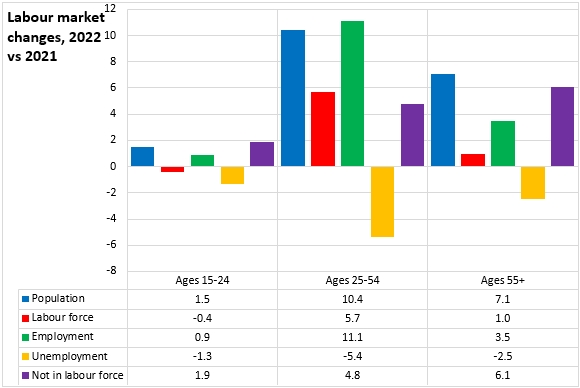
Within specific age cohorts, the decline in youth labour force and rise in persons not in the labour force was concentrated among those aged 20-24.

Cohorts from 25 to 39 years old all reported strong gains in population, labour force and employment. Cohorts aged 40-49 reported lower labour force and little overall change in employment (gains among those aged 40-44 were offset by declines among those aged 45-49).
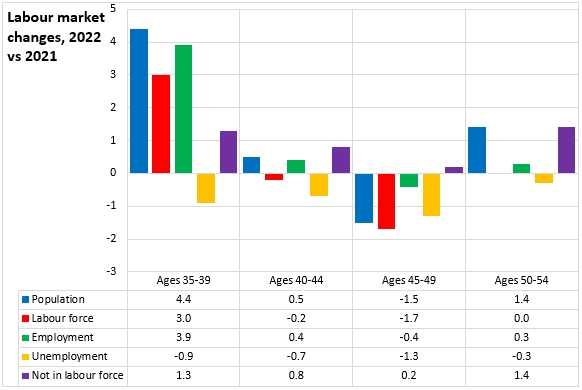
Cohorts over age 60 reported rising population, but not much increase in labour force.

Unemployment rates in 2022 were higher for younger cohorts and lowest for those in the middle of the core working ages.
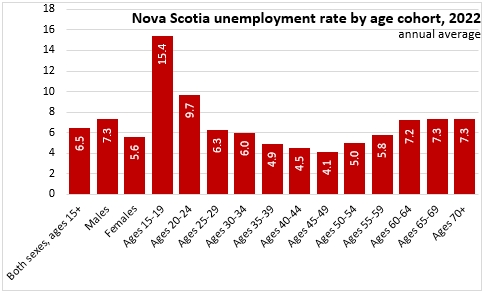
Participation rates were highest for those aged 25-54. Participation rates were almost as high for those aged 20-24 and 55 to 59. There were sharp declines in participation for those over age 60 as well as those under 20.
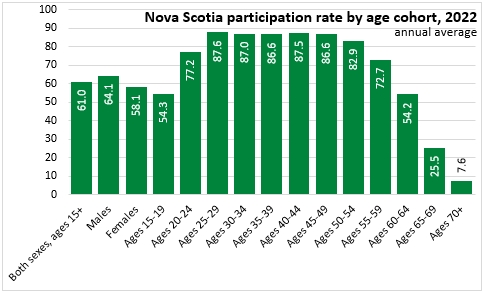
As with participation rates, employment rates were highest for those aged 25-54. Like participation rates, employment rates were almost as high for those aged 20-24 and 55 to 59, but fell off substantially for those over age 60 and under age 20.

Class of worker and industry (2022 vs 2021, annual average)
Nova Scotia's annual employment increase was attributable to increases in both private sector (+11,100) and public sector (+4,700) employment. Self employment was down slightly (-400).
Among industries, annual employment was up substantially for construction, health/social, professional/technical services, information/culture/recreation, finance/insurance/real estate, personal/repair services and accommodation/food. There were notable employment declines for transportation/warehousing, agriculture, wholesale/retail and forestry/fishing/mining.
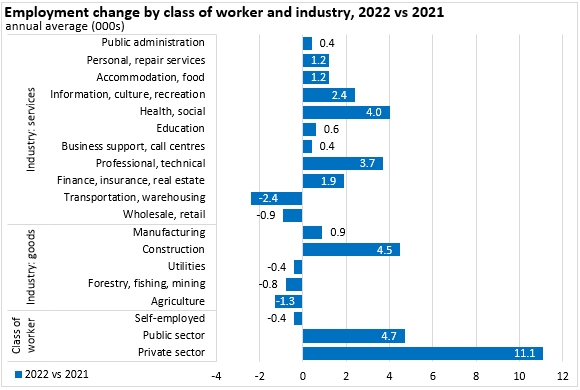
Health/social and wholesale/retail remain the largest broad industries of employment in Nova Scotia, followed by construction, professional/technical services, education, manufacturing, public administration and accommodation/food.
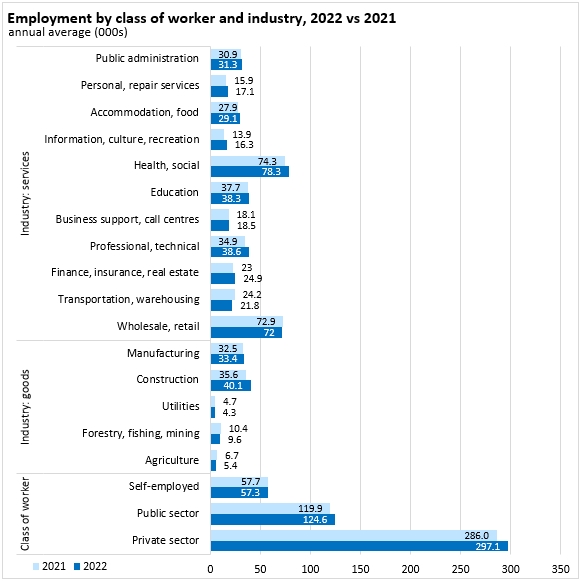
Hours worked (2022 annual average)
A larger portion of workers in services industries had part-time hours (40 hours/week).
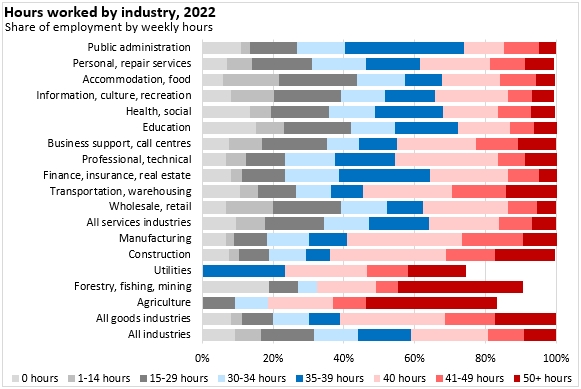
Average weekly wages (2022 vs 2021, annual average)
Nova Scotians' average weekly earnings amounted to $998.09 in 2022, up from $951.10 in 2021. Average weekly wages were highest in forestry/fishing/mining, utilities, public administration and professional/technical services. The lowest average weekly earnings were reported in accommodation/food, wholesale/retail, agriculture and business support/call centres.
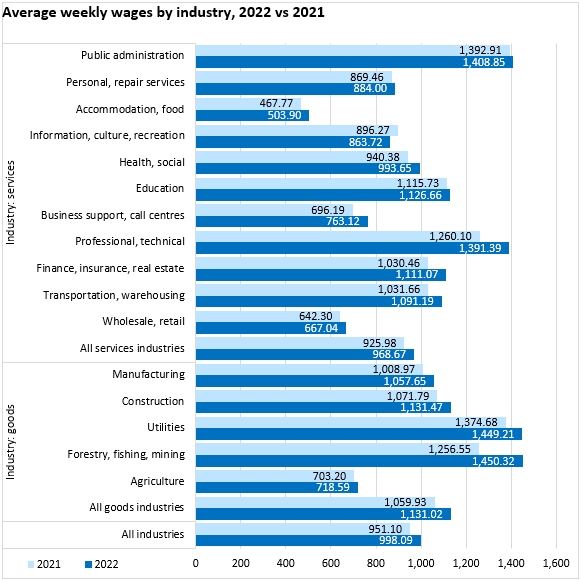
Average weekly earnings were up 4.9% from 2021 to 2022. Forestry/fishing/mining, professional/technical services, business support/call centres and accommodation/food reported the largest increases while information/culture/recreation reported the only decline in average weekly earnings.

Regions (2022 vs 2021, annual average)
All regions reported increases in population of working age. However, labour force declined in both the North Shore and Southern Nova Scotia economic regions. Employment was up in Cape Breton, the Annapolis Valley and Halifax with little change in Southern Nova Scotia and a decline in the North Shore region. Unemployment was down in all regions. There was a notable increase in persons not in the labour force in both Halifax and the North Shore regions.
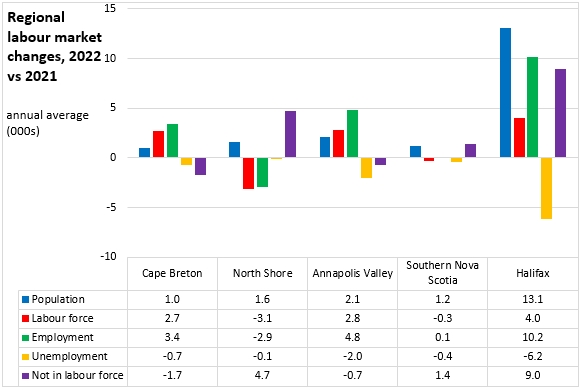
Unemployment rates were down in 2022 for all regions except the North Shore. Halifax and the Annapolis Valley reported the lowest unemployment rates on average in 2022 while Cape Breton reported the highest.
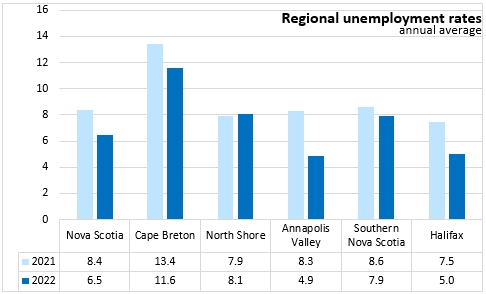
Participation rates were down overall in Nova Scotia in 2022. Participation rates fell in Halifax, Southern Nova Scotia and the North Shore economic regions while there were increases in Cape Breton and the Annapolis Valley. Despite the decline, Halifax reported the highest annual average participation rate in 2022. Cape Breton reported the lowest participation rate.
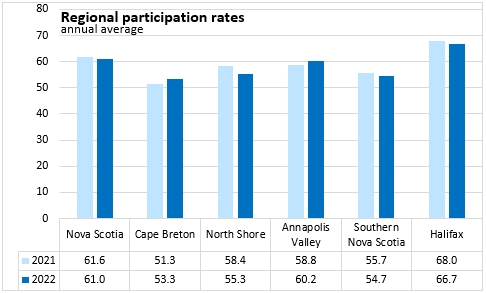
With rising employment levels outpacing population growth, employment rates were up in Halifax, the Annapolis Valley and Cape Breton economic regions. There were declines in the North Shore and Southern Nova Scotia regions. Halifax and the Annapolis Valley reported the highest employment rates while Cape Breton reported the lowest (less than 50%).
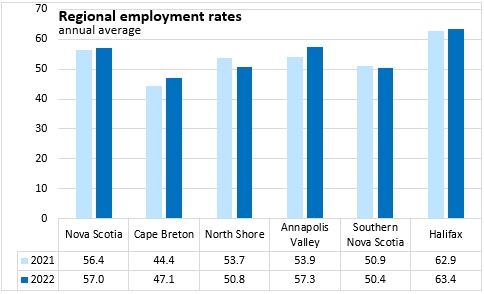
Provinces (2022 vs 2021, annual average)
Nova Scotia's labour force increase of 1.2% was similar to the national gain of 1.3%. Labour force was up in all provinces with the fastest rise in Prince Edward Island.
Likewise, Nova Scotia's employment gain of 3.4% was just below the national pace of 3.7%. All provinces reported rising employment with the fastest gains in Prince Edward Island and Alberta.
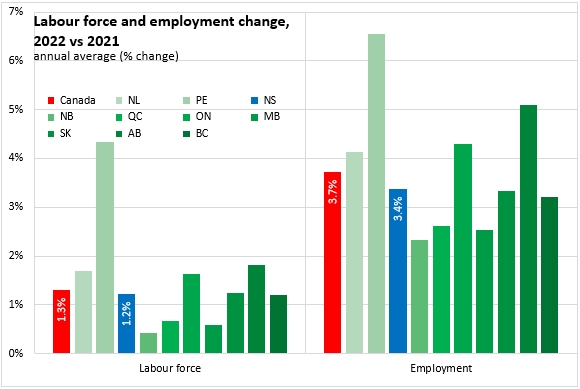
The national unemployment rate averaged 5.3% in 2022, down substantially from the 7.5% reported in 2021. Unemployment rates were down in every province. Nova Scotia's unemployment rate fell 1.9 percentage points to 6.5%. Quebec reported the lowest average unemployment rate in 2022 while Newfoundland and Labrador reported the highest.
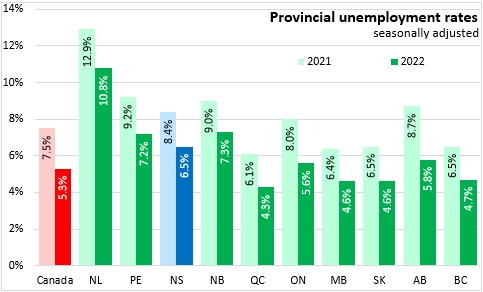
Labour force participation rates were little changed in most provinces from 2021 to 2022. The national participation rate was 65.0%, down from 65.1% in 2021. Nova Scotia's participation rate contracted more than most, falling by 0.6 percentage points to 61.0% in 2022 (only New Brunswick's participation rate contracted by more). The highest participation rates were in Alberta and Saskatchewan. Newfoundland and Labrador continues to report the lowest participation rates.
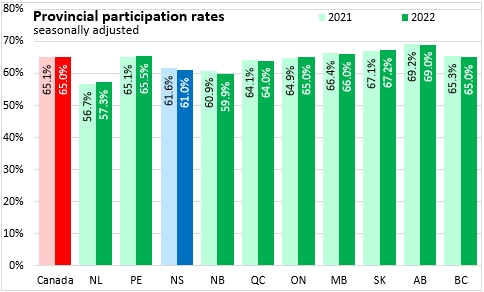
Employment rates increased in every province from 2021 to 2022. Nova Scotia's employment rate increased 0.6 percentage points to 57.0% while the national average increased by 1.4 percentage points to 61.6%. Alberta and Saskatchewan reported the highest employment rates in 2022; Newfoundland and Labrador reported the lowest.
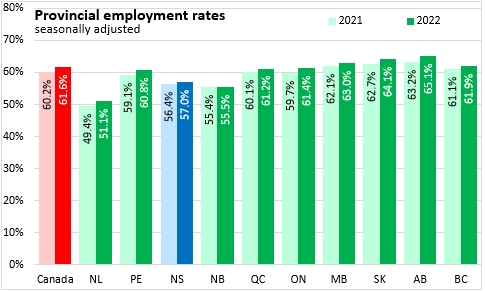
Census Metropolitan Areas (2022, annual average)
The Halifax unemployment rate averaged 5.0% in 2022. This was below the national average and lower than in the rest of Nova Scotia (8.1%). In central and western provinces, unemployment rates in Census Metropolitan Areas are similar to or higher than unemployment rates outside CMAs. In the Atlantic Provinces unemployment rates are typically higher outside CMAs.
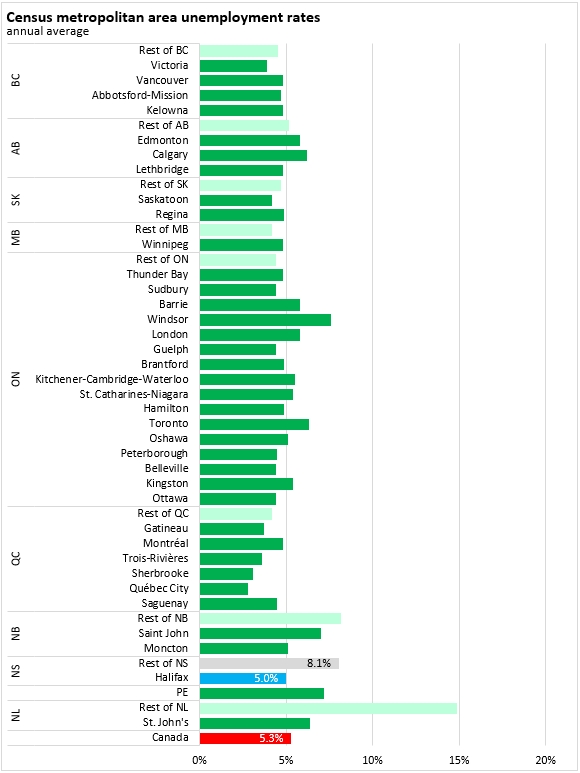
Halifax's participation rate was 66.7% on average in 2022 while participation rates were 55.9% across the rest of the province. Only Newfoundland and Labrador outside St. John's reported a lower participation rate than Nova Scotia outside of Halifax.
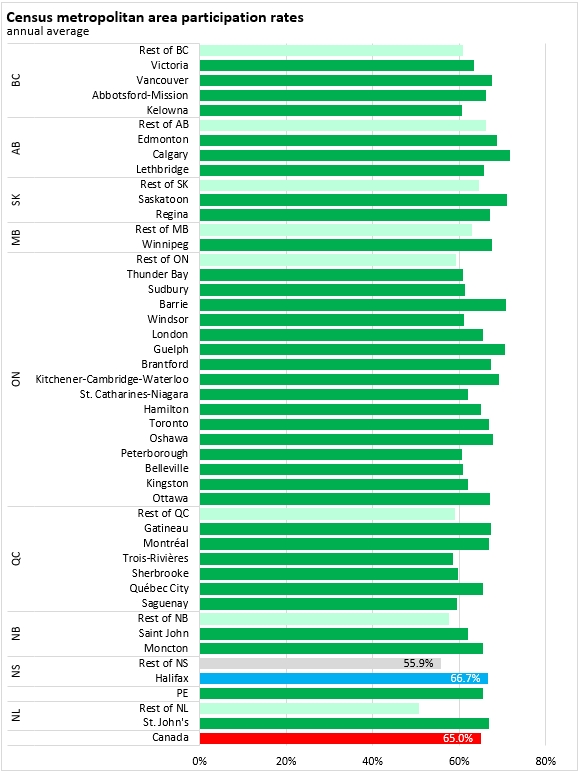
Halifax reported an employment rate of 63.4% on average in 2022 while the employment rate was 51.4% outside the city. Only Newfoundland and Labrador outside St. John's reported a lower employment rate than Nova Scotia outside of Halifax.

Sources: Statistics Canada. Table 14-10-0037-01 Actual hours worked by industry, annual; Table 14-10-0064-01 Employee wages by industry, annual; Table 14-10-0327-01 Labour force characteristics by sex and detailed age group, annual; Table 14-10-0385-01 Labour force characteristics, annual; Table 14-10-0393-01 Labour force characteristics, annual; Table 14-10-0023-01 Labour force characteristics by industry, annual (x 1,000); Table 14-10-0027-01 Employment by class of worker, annual (x 1,000)